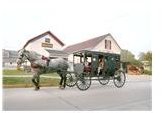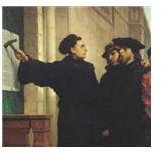Causes of the Protestant Reformation: The Renaissance and Reformation
The Renaissance and Reformation
Humanism, the renaissance school of thought that made the individual and secular world paramount to spiritual considerations, would
lead to the academic development of the Humanities. Secularism was similar to Humanism, and together they would encourage a critical review of the Catholic Church and its practices. This critique led to a call for reformation of the Church amongst Europeans, and to events that grew to be causes of the Protestant Reformation.
The Protestant Reformation
During the 16th century a monk preaching in Wittenberg, Germany, Martin Luther, worried over his own soul and salvation. His reading of a passage in Saint Paul’s Epistle to the Romans would not only end his concerns, but become the seed of a new religious doctrine. Luther interpreted the passage “He who through faith is righteous shall live” to mean faith alone could make a person good and just. His belief became known as justification by faith.
Over time, Luther’s ideas would bring him at odds with the church and pope. He spoke out against the sale of indulgences: They were certificates which guaranteed the removal or reduction of punishment for sins if the sinner honestly repented. The church’s agent for indulgence sales, John Tetzel, issued them to ensure relief of future sins, and those of relative’s passed on.
Luther spoke out against these certificates, and on October, 31, 1517, nailed his Ninety-Five Theses,
or criticisms, of church practices. Copies spread through Germany and indulgence sales fell. Pope Leo X sent messengers to dissuade Luther but he refused. The pope condemned Luther and banned his works in 1520, and in 1521 he excommunicated the monk.
The Diet of Worms
A council, or diet, of princes gathered in Worms to try to bring Martin Luther back to the church. They decided he should retract his criticisms. Luther, who was met by throngs of supporters when he traveled to the city, refused. Condemned a heretic, Luther was given refuge in Wartburg by Prince Frederick of Saxony and translated the New Testament into German while there.
Lutheranism
Lutheranism grew with its basis being salvation through faith and the Bible as the sole supplier of religious truth, unlike Catholicism, which emphasized church tenets, good deeds, and faith as the road to salvation. In addition, there was no church hierarchy.
This democratic attitude stirred the lower classes to resist serfdom and contributed to a peasant revolt in 1525. Concerned about more turmoil, Luther took the side of the princes, who crushed the peasants brutally. Thousands died and since that time Lutheranism has been more conservative.
Reformed Churches of Switzerland
Huldrych Zwingli wanted to break completely from Catholic tradition and establish a theocracy in Zurich making it a city run by the state. This happened in 1525 but in 1531 a war erupted due to Protestant missionaries in a Catholic area and Zwingli was defeated.
John Calvin began a similar Reformed church in Geneva after publishing The Institutes of the Christian Religion in 1536. The center of Calvinism was predestination, the belief that God decides and directs the fate of everyone and everything.
Travelers helped to spread the religion, and people of the Netherlands and Scotland became strong followers. John Knox, a Scottish Reformer encouraged people to rid themselves of “ungodly” rulers, as did other Calvin supporters. In this way, Calvinism contributed to revolutionary ideals and movements in the Seventeenth and Eighteenth Centuries.
The Anabaptists
More radical in nature, these Protestant sects advocated baptizing or admitting only adults, rejecting local government, and refusing to

take oaths or engage in warfare. Most were peaceful but some groups were fanatical and in 1534 one such group took control in Munster. They seized property and lived in polygamous marriages. Lutherans and Catholics united and defeated them. Survivors were severely punished.
Anabaptist groups fled to North America bringing with them the notions of freedom of religion and separation of church and state. Baptists, Mennonites, and Amish alike can trace their heritage back to Anabaptists.
Henry VIII and the Church of England
It’s hard to look at King Henry in the same light as the other reformers, given he broke from the church to get his own way, divorce Catherine of Aragon, and marry young Anne Boleyn. However, it’s a fun story and did result in a Protestant church.
Henry VIII was distressed about not having a male heir. He and Catherine had six children, of whom only one survived, Mary. The King

asked the pope for permission to divorce Catherine in hopes of having a son with Anne. Catherine’s nephew, the Holy Roman Emperor Charles V, was responsible for the pope’s protection. Charles V advised the pope to refuse Henry. He did, and an enraged Henry with he help of Parliament, passed a set of laws separating the English church from Rome. Chief among these laws was the Act of Supremacy (1534). It established Henry VIII as the head of the English church. Basically, the new English church stayed true to Catholic tradition and canon. Stanch Catholics such as Thomas More resisted Henry and suffered the consequences. More lost his head, literally, and Catholic land was taken with the wealth divided amongst the nobility. Henry and Anne would have Elizabeth. He would marry four more times and have one son, Edward VI.
After Edward VI’s brief reign, Mary tried to bring back Catholicism and had many Protestants burned at the stake. Bloody Mary’s efforts had the opposite effect, only strengthening her people’s favor for the English church. Her half-sister Elizabeth took a different approach. She combined elements from both Catholic and Protestant customs, creating Anglicanism.
Image Credits
https://landmarksofliberty.blogspot.com/2009/10/95-theses-that-changed-world-october-31.html
https://commons.wikimedia.org/wiki/File:Shipshewana-indiana-amish-buggy.jpg
https://www.ict.oxon-lea.gov.uk/best_practice/henry/The%20Wives%20of%20Henry%20VIII.htm
